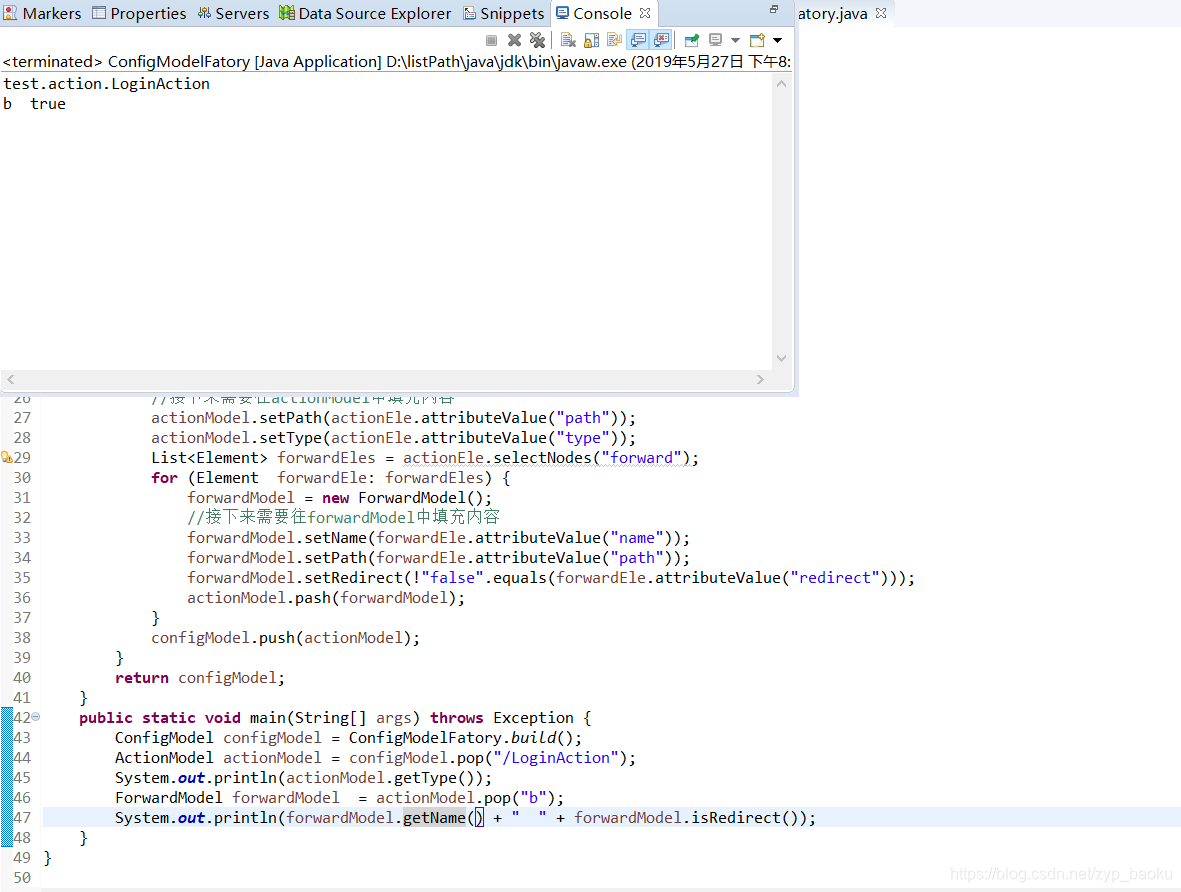建模的简介与思路
建模的由来:就是将指定的xml字符串当作对象来操作
建模的优点:如果说当对一个指定的xml格式字符串完成了建模操作,只需要调用指定的方法就可以完成预定的字符串获取。
建模的思路:
1、分析需要被建模的文件中有那几个对象
2、每个对象拥有的行为以及属性
3、定义对象从小到大(从里到外)
4、通过23种的设计模式中的工厂模式,解析xml生产出指定对象
好处:提高代码的复用性
XML建模
ConfigModel类
package com.zking.xml.mode;
import java.util.HashMap;
import java.util.Map;
public class ConfigModel {
private Map<String, ActionModel> acMap = new HashMap<>();
public void push(ActionModel actionModel) {
acMap.put(actionModel.getPath(), actionModel);
}
public ActionModel pop(String path) {
return acMap.get(path);
}
public static void main(String[] args) {
ConfigModel configModel = new ConfigModel(); //null a null
ActionModel a = configModel.pop("/LoginAction");
}
}
ActionModel类
package com.zking.xml.mode;
import java.util.HashMap;
import java.util.Map;
public class ActionModel {
// <action path="/LoginAction" type="test.action.LoginAction">
private String path;
private String type;
private Map<String, ForwardModel> fMap = new HashMap<>();
public String getPath() {
return path;
}
public void setPath(String path) {
this.path = path;
}
public String getType() {
return type;
}
public void setType(String type) {
this.type = type;
}
public void pash(ForwardModel forwarModel) {
fMap.put(forwarModel.getName(), forwarModel);
}
public ForwardModel pop(String name) {
return fMap.get(name);
}
}
ForwardModel类
package com.zking.xml.mode;
public class ForwardModel {
// <forward name="a" path="/index.jsp" redirect="false" />
private String name;
private String path;
private boolean redirect;
public String getName() {
return name;
}
public void setName(String name) {
this.name = name;
}
public String getPath() {
return path;
}
public void setPath(String path) {
this.path = path;
}
public boolean isRedirect() {
return redirect;
}
public void setRedirect(boolean redirect) {
this.redirect = redirect;
}
}
ConfigModelFactory类
package com.zking.xml.mode;
import java.io.InputStream;
import java.util.List;
import org.dom4j.Document;
import org.dom4j.Element;
import org.dom4j.io.SAXReader;
public class ConfigModelFatory {
public static ConfigModel build() throws Exception {
return build("config.xml");
}
private static ConfigModel build(String xmlPath) throws Exception {
ConfigModel configModel = new ConfigModel();
InputStream in = ConfigModelFatory.class.getResourceAsStream(xmlPath);
SAXReader saxReader = new SAXReader();
Document doc = saxReader.read(in);
ActionModel actionModel = null;
ForwardModel forwardModel = null;
List<Element> actionEles = doc.selectNodes("/config/action");
for (Element actionEle : actionEles) {
actionModel = new ActionModel();
//接下来需要往actionModel中填充内容
actionModel.setPath(actionEle.attributeValue("path"));
actionModel.setType(actionEle.attributeValue("type"));
List<Element> forwardEles = actionEle.selectNodes("forward");
for (Element forwardEle: forwardEles) {
forwardModel = new ForwardModel();
//接下来需要往forwardModel中填充内容
forwardModel.setName(forwardEle.attributeValue("name"));
forwardModel.setPath(forwardEle.attributeValue("path"));
forwardModel.setRedirect(!"false".equals(forwardEle.attributeValue("redirect")));
actionModel.pash(forwardModel);
}
configModel.push(actionModel);
}
return configModel;
}
public static void main(String[] args) throws Exception {
ConfigModel configModel = ConfigModelFatory.build();
ActionModel actionModel = configModel.pop("/LoginAction");
System.out.println(actionModel.getType());
ForwardModel forwardModel = actionModel.pop("b");
System.out.println(forwardModel.getName() + " " + forwardModel.isRedirect());
}
}
输出后

注:属性为String类型,子元素标签则是map的值,子元素标签的唯一标识则为map的值
建模分两步:
1、以面向对象的编程思想,描述xml资源文件
2、将xml文件中内容封装进model实体对象。
想要了解更多,私信博主。